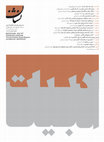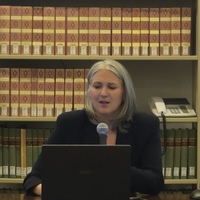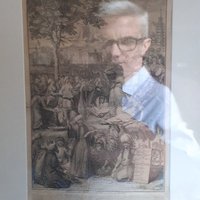Papers by Borna Izadpanah
BBC News, 2021
بیش از ۱۸۰ سال از پیدایش اولین روزنامه در ایران که به "کاغذ اخبار" معروف است میگذرد با این حال د... more بیش از ۱۸۰ سال از پیدایش اولین روزنامه در ایران که به "کاغذ اخبار" معروف است میگذرد با این حال دانستهها دربارهی این روزنامه تا سالهای اخیر بیشتر محدود به اسناد دست دوم و نقل قولهایی از پژوهشگران و تاریخنگاران معاصر بوده است. در این یادداشت تلاش شده تا با نگاهی به پیشینهی برخی پژوهشهای مرتبط و با توجه به اسناد نو یافته، تاریخچهی بهروزتری از سرگذشت این روزنامه ارایه داده شود.
جهان کتاب, 2021
این مقاله، مقدمهای است بر پیدایش چاپ و حروفریزی فارسی در اروپا در اواخر قرن شانزدهم و اوایل قرن... more این مقاله، مقدمهای است بر پیدایش چاپ و حروفریزی فارسی در اروپا در اواخر قرن شانزدهم و اوایل قرن هفدهم میلادی است. تاریخدانان صنعت چاپ اغلب با غفلت فراوانی از کنار این موضوع عبور کردهاند. شاید برای نخستین بار و به طور مشخّص، این مقاله بر ابعاد مختلف مربوط به طرّاحی و ساخت حروف چاپی فارسی در چاپخانۀ شرقی مدیچی و چاپخانۀ کنگرۀ ترویج ایمان در رُم، تمرکز دارد. از این گذشته، این پژوهش، این ادعای پیشین را که «هیستوریا کریستی پرسیچه» یا «داستان مسیح» (لَیدن، ۱۶۳۹) نخستین کتاب فارسی چاپشده است، به چالش میکشد. همچنین مقالۀ حاضر، روشن میکند که کتابی به نام «آلفابتوم پرسیکوم» یا «الفبای فارسی» (رُم، ۱۶۳۳) که قدیمی تر از «داستان مسیح» بود، نخستین کوششها در زمینهٔ چاپ کتاب به زبان فارسی است.

Neshan 46/47, 2019
On January 25th, 1962, Kayhan, one of the leading Tehran newspapers, announced on its front page ... more On January 25th, 1962, Kayhan, one of the leading Tehran newspapers, announced on its front page that a new headline typeface called Horuf-e 84 siyah-e Kayhan [Kayhan 84 Black] had been designed for the newspaper. According to this report, the design and production of this type had been initiated one year earlier and in collaboration with the Elham type foundry in Tehran; however, there was no mention of the designer of this typeface. On January 23rd, 1962, Kayhan’s main headline was for the first time set in Kayhan 84. Around two years later, Ettela’at, another leading Tehran newspaper, gradually began to use Kayhan 84 that was first used for typesetting its main headline on 3 November 1963. Ultimately on 4 March 1969, Ettela’at introduced the designer of Kayhan 84, Hossein Abdollahzadeh Haghighi (1937 Tabriz – 2003 Tehran), who had designed this typeface when he was only 25 years old.
British Library Asian and African Studies Blog, 2019
Journal of the Printing Historical Society, 2018
This article offers an introduction to Persian printing and typefounding in Europe during the lat... more This article offers an introduction to Persian printing and typefounding in Europe during the late sixteenth and early seventeenth centuries, a subject which has largely eluded rigorous investigation by printing historians. More specifically, it focuses on the Persian typographical materials of the Medici and Propaganda Fide presses which are presented here, perhaps for the first time. Furthermore, this study questions the conventional claim by historians to date that 'Historia Christi Persice' (Leiden, 1639) was the first printed Persian book, and traces initial attempts at Persian printing that included an earlier publication, 'Alphabetum Persicum' (Rome, 1633).
MA in Typeface Design Dissertation, University of Reading, 2015
Conference Presentations by Borna Izadpanah

ISType — Mukaddeme, 2022
Arabic-script printing with movable type was introduced to Iran in the second decade of the ninet... more Arabic-script printing with movable type was introduced to Iran in the second decade of the nineteenth century. It was practised in Tabriz, Tehran and Isfahan until 1859 when the last known publication of this early phase was printed in Tehran. The reintroduction of Arabic-script printing with movable type coincided with the first European tour of the fourth Qajar monarch of Iran Naṣir al-Dīn Shāh (R. 1848–1896). Reportedly, while in Istanbul and on his return to Iran Naṣir al-Dīn Shāh ordered the purchase of a typographic press and Arabic and Latin types with which the diary of his first travel to Europe was published in 1874. Towards the end of the nineteenth century, other Ottoman and European naskh types were imported and employed in Iranian printing establishments. This talk explores the origins of these naskh types and their long-lasting legacy in forming the twentieth-century Persian typography in Iran.

ATypI Paris, 2023
Imagine belonging to an Asian language community which for centuries has considered the art of wr... more Imagine belonging to an Asian language community which for centuries has considered the art of writing an integral component of its cultural identity and an essential element of its visual communication and artistic expression. It has produced eminent artists and skilled craftspeople who have employed letterforms in the most creative, efficient, and imaginative way. It has successfully survived conflicts and divisive forces of every conceivable nature. Despite this background, your language is poorly represented in typographic environments today. This description applies to several language groups that use Arabic script or its modified forms. Although still inadequate, better typographic choices are available for users of languages like Arabic and Persian; however, only a handful of Arabic script digital typefaces exist for South-Asian languages (such as Pashto, Sindhi, and Urdu), whose users form around one-third of the world’s Muslim population.
This presentation examines specific historical, cultural, economic, and socio-political cases that contributed to the current state of Arabic script typography and the surprisingly disproportionate representation of different languages. It also addresses issues around the imposition of Latin script typographic standards and aesthetic values on Arabic script and the lack of support for its localized forms. Drawing from significant historical examples of type-making from vernacular type foundries and printing presses, it argues that many of the current shortcomings in the design and development of Arabic script typefaces are not due to the ‘complexity’ of writing styles but either uninformed or deliberate choices of companies and individuals. It emphasizes the importance of reflecting cultural, linguistic and stylistic preferences of languages that use the Arabic script. The aim is to encourage more dialogue to apply a decolonial lens to norms and practices in academia and the industry concerned with textual communication in various world languages.

2024 CERL ANNUAL SEMINAR, 2024
This paper investigates the establishment of the Collection Orientale, a visionary printing endea... more This paper investigates the establishment of the Collection Orientale, a visionary printing endeavour undertaken by the Imprimerie royale in the 1830s, designed to showcase the richness of oriental manuscripts housed in the Bibliothèque du Roi. Originally mandated in 1813 and revived in 1825, the project aimed to print revered Eastern works in their original scripts with French translations, combining artistic and scholarly endeavours to assert France’s cultural superiority in Europe. Despite numerous setbacks and delays, the initiative gained momentum in the 1830s under the direction of Pierre-Antoine Lebrun, who assembled a distinguished committee of orientalists and scholars to oversee the project’s execution. The Collection Orientale was conceived as both a typographical and scholarly triumph, blending rigorous academic investigation with magnificent artistry. This paper traces the intricate processes of commissioning, translation, and typographic execution, highlighting the roles of key figures.

Centre for Book Cultures and Publishing, 2022
This seminar introduced some of the particularities and challenges that Borna’s recently complete... more This seminar introduced some of the particularities and challenges that Borna’s recently completed PhD research faced in developing the chapter that deals with the introduction of Arabic-script printing to nineteenth-century Iran. One of the significant aspects of Arabic-script metal types produced in Iran is their extremely minimal use. This is also true of the number of surviving copies of the early Persian publications in Iran which were printed with those types. For example, the first Qurʾān printed with both typography (1827) and lithography (1834) are limited to two identified copies. Additionally, the condition of extant copies of books printed in Iran during this period are often extremely poor and, in many cases, incomplete.
This presentation demonstrates Borna’s experience of investigating the early Persian publications in Iran, which shows that many of these publications have yet to be identified. The discovery of previously unknown publications in libraries or private collections – which is not an infrequent occurrence – often overturns the received history of printing in Iran.

ISType, 2019
This paper has two objectives: the first briefly considers some of the inadequacies in the existi... more This paper has two objectives: the first briefly considers some of the inadequacies in the existing literature – particularly those written in European languages – that generally claim to investigate the history of printing in the Arabic script or document printing in the Middle East. This discussion sets the context for the second and primary objective of this paper which is to explore the introduction of printing and typefounding in nineteenth-century Iran. A few scholars have focused on different aspects of print history in Iran (mainly printing with lithography); however, there seems to be little serious discussion of this subject from the perspective of typefounding within the wider context of Arabic-script printing. Yet, as will be shown, the under-studied history of printing in Iran reveals significant and pioneering achievements in Arabic-script printing and typefounding that began in the nineteenth century.
Technologies of print in South & Southeast Asia: the social history of modes of production, 2019
Royal Asiatic Society, London
Multiple impressions: the coexistence of scribal practices and printing technologies in texts, 2018
SOAS, University of London
ATypI, 2018
Arenberg theatre, Antwerp
Arabic and Persian Printing History and Culture, 2016
University of Birmingham
Thesis Chapters by Borna Izadpanah
PhD Thesis, 2021
Department of Typography & Graphic Communication, University of Reading, UK.
Books by Borna Izadpanah
Arabic Typography: History and Practice , 2022
This chapter explores the introduction of Persian and Arabic printing with movable type in ninete... more This chapter explores the introduction of Persian and Arabic printing with movable type in nineteenth century Iran, a severely understudied subject in the general discussion of the history of Arabic script printing. Furthermore, it discusses various founts of type in the Persian naskh style which were used for publishing books in the formative period of Persian printing in the Iranian cities of Tabriz, Tehran, and Isfahan.
Book Reviews by Borna Izadpanah
International Journal of Middle East Studies, 2022











Uploads
Papers by Borna Izadpanah
Conference Presentations by Borna Izadpanah
This presentation examines specific historical, cultural, economic, and socio-political cases that contributed to the current state of Arabic script typography and the surprisingly disproportionate representation of different languages. It also addresses issues around the imposition of Latin script typographic standards and aesthetic values on Arabic script and the lack of support for its localized forms. Drawing from significant historical examples of type-making from vernacular type foundries and printing presses, it argues that many of the current shortcomings in the design and development of Arabic script typefaces are not due to the ‘complexity’ of writing styles but either uninformed or deliberate choices of companies and individuals. It emphasizes the importance of reflecting cultural, linguistic and stylistic preferences of languages that use the Arabic script. The aim is to encourage more dialogue to apply a decolonial lens to norms and practices in academia and the industry concerned with textual communication in various world languages.
This presentation demonstrates Borna’s experience of investigating the early Persian publications in Iran, which shows that many of these publications have yet to be identified. The discovery of previously unknown publications in libraries or private collections – which is not an infrequent occurrence – often overturns the received history of printing in Iran.
Thesis Chapters by Borna Izadpanah
Books by Borna Izadpanah
Book Reviews by Borna Izadpanah
This presentation examines specific historical, cultural, economic, and socio-political cases that contributed to the current state of Arabic script typography and the surprisingly disproportionate representation of different languages. It also addresses issues around the imposition of Latin script typographic standards and aesthetic values on Arabic script and the lack of support for its localized forms. Drawing from significant historical examples of type-making from vernacular type foundries and printing presses, it argues that many of the current shortcomings in the design and development of Arabic script typefaces are not due to the ‘complexity’ of writing styles but either uninformed or deliberate choices of companies and individuals. It emphasizes the importance of reflecting cultural, linguistic and stylistic preferences of languages that use the Arabic script. The aim is to encourage more dialogue to apply a decolonial lens to norms and practices in academia and the industry concerned with textual communication in various world languages.
This presentation demonstrates Borna’s experience of investigating the early Persian publications in Iran, which shows that many of these publications have yet to be identified. The discovery of previously unknown publications in libraries or private collections – which is not an infrequent occurrence – often overturns the received history of printing in Iran.